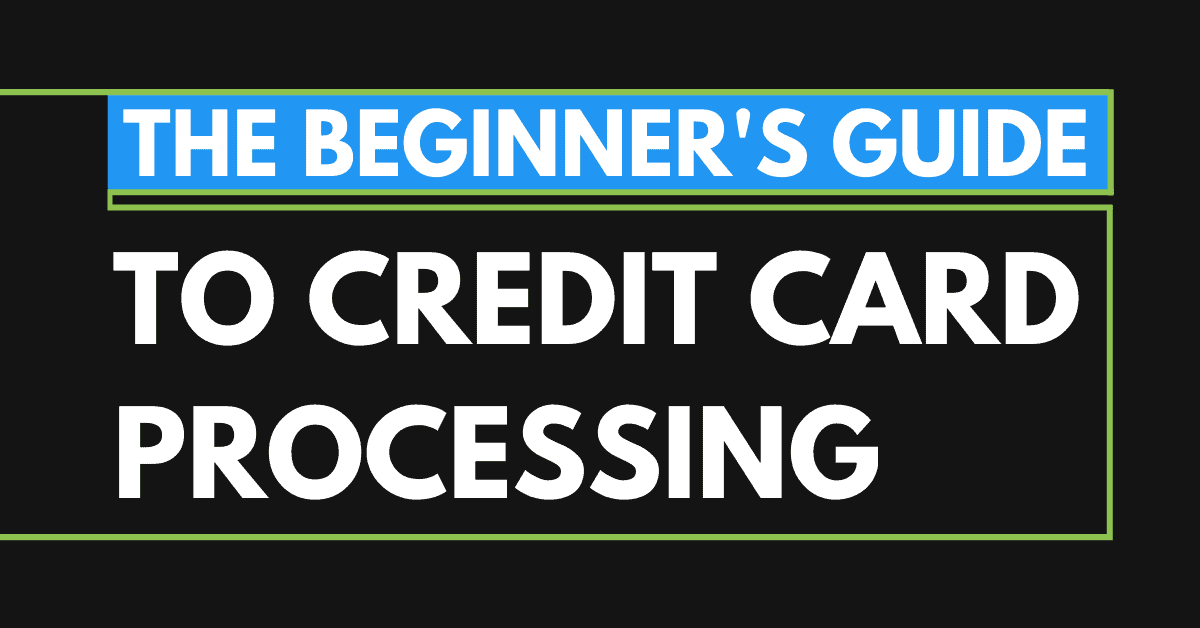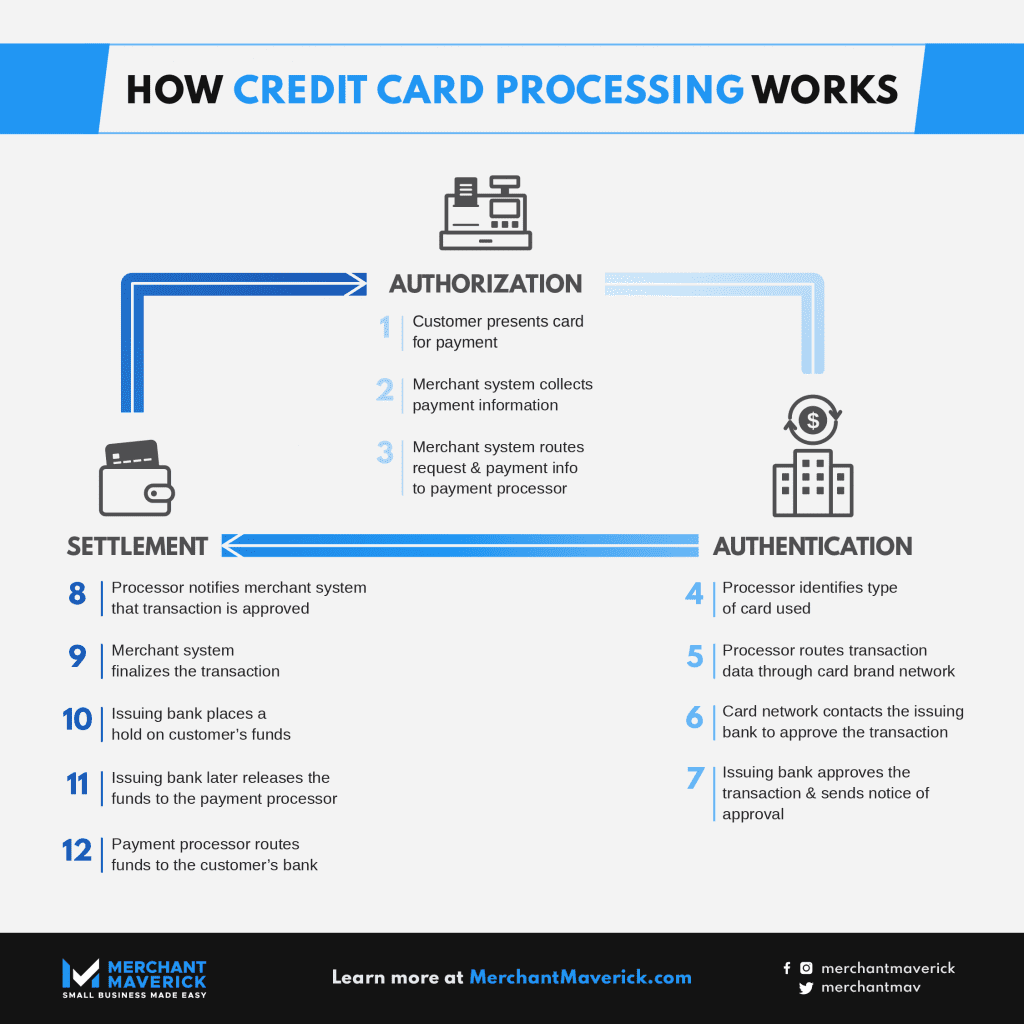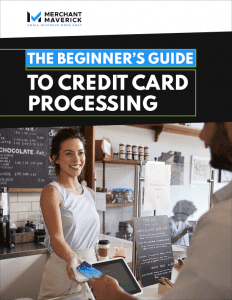Learn How Credit Card Processing Works: The Beginner’s Guide to Credit Card Processing (Diagram + eBook)

Merchants and customers appreciate the convenience of credit card payments. However, rarely do either question the process or the many players involved in credit card processing. Here’s the truth: As digital and cashless payments become ever more popular, small business owners and merchants need to know how credit card processing works.
You don’t need to become an industry expert. But you do need to take the time to learn the basics of payment processing, who the major players are, and how to find the right match for your business’ payment processing needs.
In The Beginner’s Guide To Credit Card Processing, you’ll find all the basics of payments explained step by step, including how credit card processing works, credit card processing fees, how to shop for a payment processor, and what to look for in hardware and software. Keep reading for a sneak peek at some of the information in the ebook and more.
How Does Credit Card Processing Work? [Diagram]

For visual thinkers, imagine credit card processing as a cycle that works as you see above. The cycle begins and ends at the merchant’s point of sale, where the transaction is initiated (authorization), and funds are eventually deposited (settlement). Besides the merchant and the customer, several parties are involved, including the customer’s bank, the merchant’s acquiring bank, and the payment processor.
Who Is Involved In Credit Card Processing?
When you accept a credit card payment at your business, it’s easy to think that you, your customer, and the customer’s bank are the only parties involved. The truth is there are several other players involved in any given credit card transaction.
- Merchant: Merchants sign a contract (also known as a “merchant agreement”) with a payment processor. This allows you to accept credit card payments and access the tools and software provided by the processor. The agreement also lays out costs and obligations.
- Acquiring Bank: Also known as an acquirer or merchant bank, this is the financial institution that routes funds, assesses risk, and communicates with the customer’s bank. This is not the same organization as your business bank account provider.
- Payment Processor: This is the organization with which the merchant signs an agreement. The payment processor provides the equipment to the merchant, handles customer service and technical support, and communicates with the acquiring bank. In some cases, payment processors and acquiring banks can be the same entity, but not always. They do work together to handle payments for the merchants, however.
- Customer: The customer is also known as a cardholder.
- Issuing Bank: The issuing bank is the organization that grants the customer a card. The issuing bank handles the final approval for all transactions.
- Credit Card Networks: Credit card networks — also known as card associations or card brands — are the organizations that control the use and acceptance of cards. These are the big names: Visa, Mastercard, Discover, and American Express. They actually have very little to do with individual transactions and instead mostly control which entities can issue cards under their brand name and set rules for business operations.
Additionally, payment processing frequently involves other invisible entities. For example, companies that license their software and hardware for use by payment providers and make it possible for you to accept card payments.
The main takeaway here is that many pieces and parties are required to make credit card processing happen. While you’ll never interact with most of them directly, they must all be paid for their role in facilitating a payment transaction, however small.
How Do Credit Card Transactions Work?
The credit card transaction process can be summed up in three stages, though multiple steps happen in each stage. Those three stages include:
- Authorization
- Authentication
- Settlement
Authorization
In the authorization stage, the customer (cardholder) initiates the payment, either by completing an online purchase or presenting their card to a merchant for payment in-store. The merchant’s payment gateway or credit card machine collects the cardholder data and begins formulating a request for funds.
After the payment is authorized, the merchant’s system sends the information about the transaction — including the amount, the cardholder’s name and account number, and other relevant details — to the payment processor, which handles the next step: authentication.
Authentication
The processor’s job is now to verify the transaction is legitimate. To authenticate a payment, the processor’s system takes the information sent and identifies the card type (the card brand). The processor then routes the information through the appropriate card network.
From there, the card networks can determine what bank issued the card and send a request for the funds to that bank. The issuing bank then internally checks the account, ensuring that the account is in good standing and that funds are available, and sends back an approval message.
Settlement
In the settlement stage, the merchant’s system receives the approval message and finalizes the transaction. At the same time, a temporary hold is placed on the funds in the customer’s account for the transaction amount.
Afterward, the processor/acquiring bank communicates with the issuing bank to collect the funds from the customer and deposit them into the merchant’s bank account, a process that can take two to three business days.
Master The Fundamentals Of How Credit Card Processing Works
 Understanding the credit card transaction process is a great start, but it’s just one small part of a very broad topic. There’s plenty more to learn about credit card payment processing to help merchants manage their business better, including minimizing their costs.
Understanding the credit card transaction process is a great start, but it’s just one small part of a very broad topic. There’s plenty more to learn about credit card payment processing to help merchants manage their business better, including minimizing their costs.
The Beginner’s Guide To Credit Card Processing has everything small businesses need to familiarize themselves with the topic. This newly refreshed ebook features brand-new content written by Merchant Maverick’s own team of experts. Topics covered in the ebook include:
- How credit card processing works
- The difference between types of payment processors
- How to choose the right processor for your business
- How credit card processing fees work
- How different pricing models for payment processing can affect your business
- How to shop for and compare different credit card processors to find the best deal
- And more!


